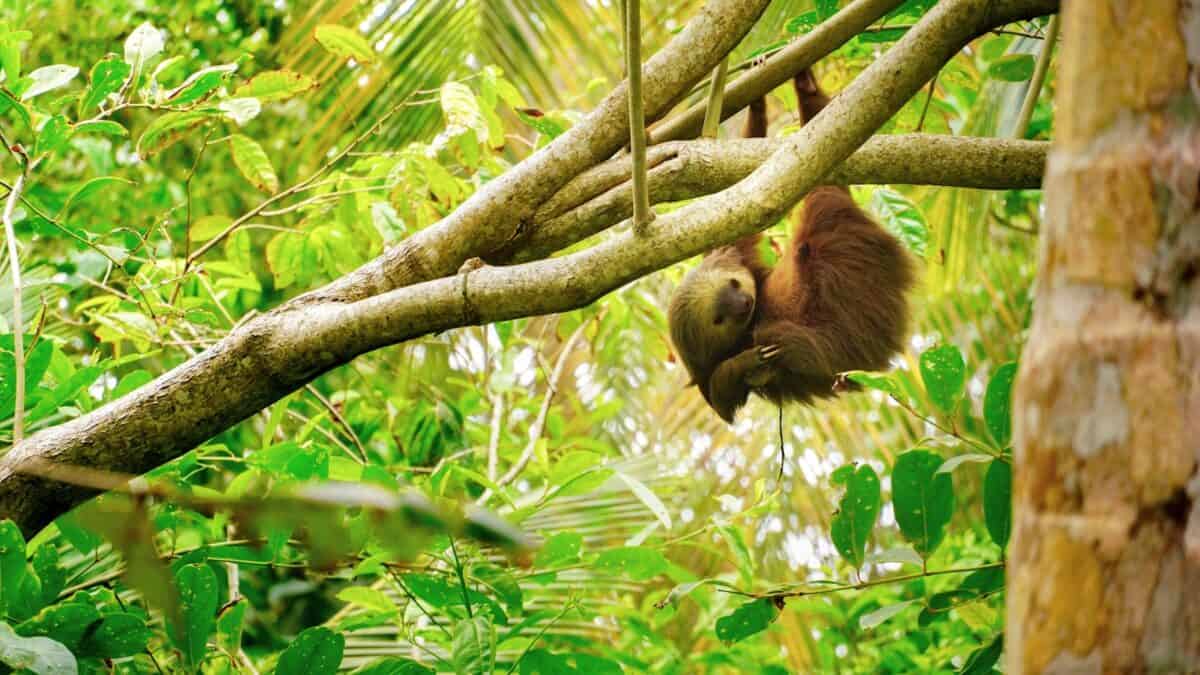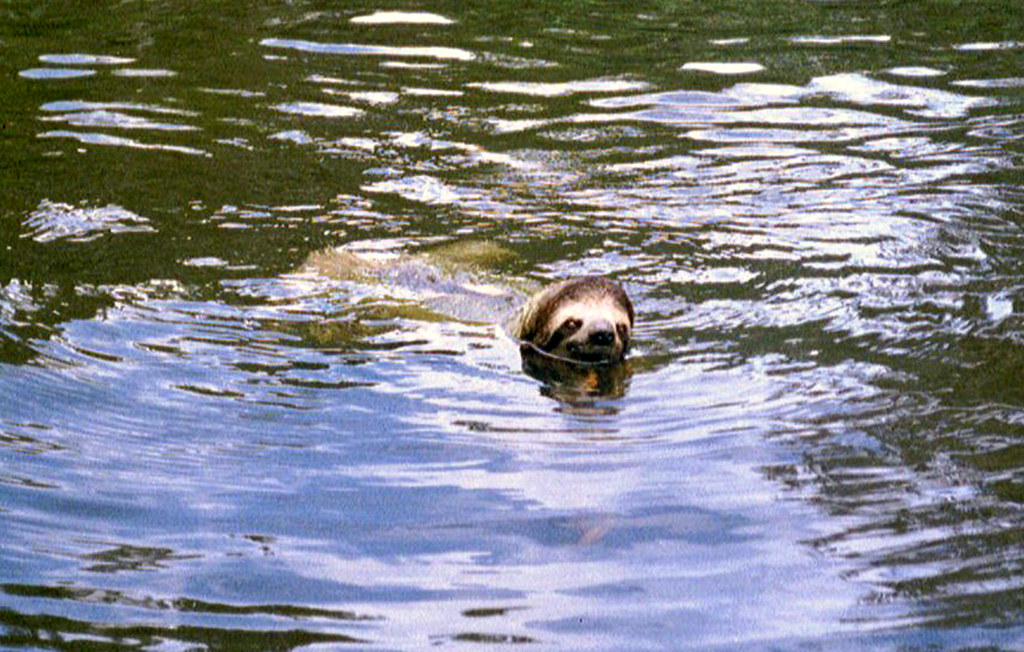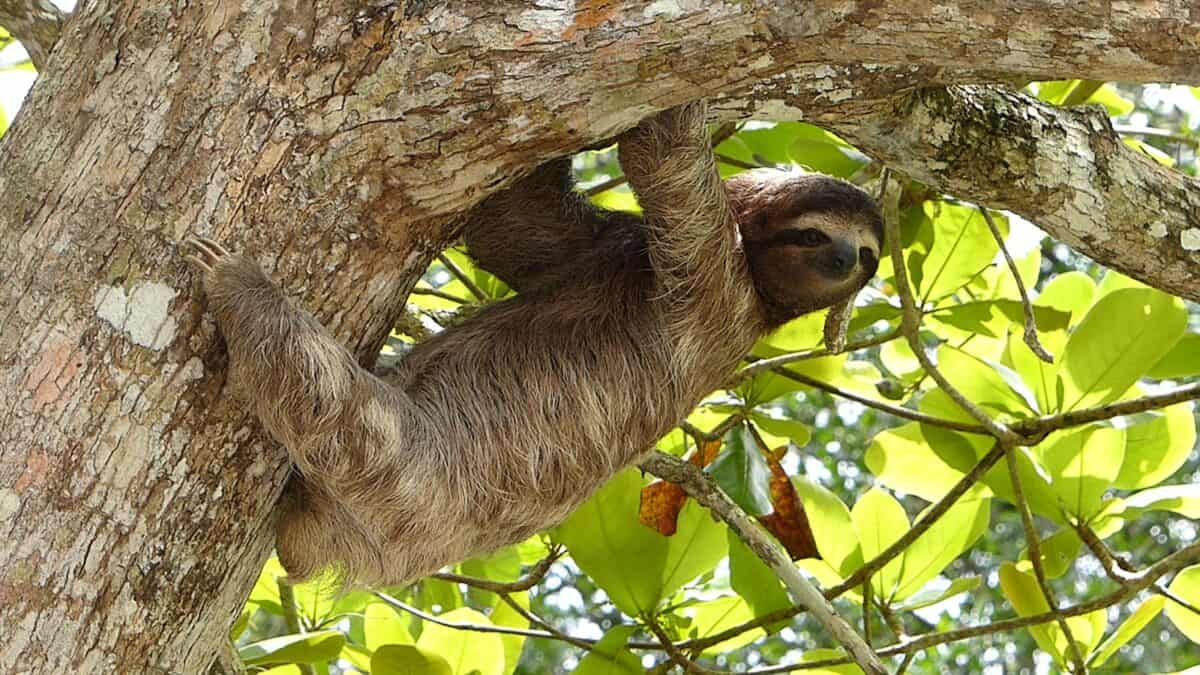In a remarkable paleontological discovery that has excited scientists and fossil enthusiasts alike, workers conducting routine dredging operations in the Peace River near Arcadia, Florida, recently unearthed a nearly complete skeleton of a giant ground sloth. This extraordinary find, identified as belonging to the species Eremotherium laurillardi, dates back to the Pleistocene epoch, approximately 12,000 years ago.
The discovery provides an unprecedented window into Florida’s prehistoric past and offers new insights into the megafauna that once roamed the southeastern United States before their extinction. As researchers carefully extract and analyze this rare specimen, the scientific community is eager to learn what new information this ancient giant might reveal about climate change, extinction events, and the ecological history of the Florida peninsula.
The Unexpected Discovery

The discovery occurred during a routine sand dredging operation near Arcadia in central Florida. Workers noticed unusual large bones emerging from the riverbed sediment and immediately halted operations. The site was quickly secured, and paleontologists from the Florida Museum of Natural History were called to assess the find. What made this discovery particularly significant was not just the presence of giant sloth remains—which have been found in Florida before—but the remarkable completeness of the specimen. Most fossil discoveries consist of fragmentary remains, but initial assessments indicate this skeleton may be more than 80% complete, including the skull, which is often missing from such finds due to its fragile nature. The discovery site’s waterlogged conditions created an oxygen-poor environment that helped preserve the bones in exceptional condition.
The Identity of the Ancient Giant

Experts have identified the remains as belonging to Eremotherium laurillardi, one of the largest species of ground sloths that ever existed. Unlike their modern tree-dwelling relatives, which typically weigh less than 20 pounds, these prehistoric giants stood approximately 15 feet tall when rearing on their hind legs and could weigh up to 5 tons—comparable to modern elephants.
Preliminary dating methods suggest this individual lived during the Late Pleistocene, roughly 12,000 years ago, placing it near the end of the last ice age and close to the time when these magnificent creatures went extinct. Researchers have determined that the specimen was an adult male, based on the size and morphology of certain skeletal elements. The skeleton shows no obvious signs of pathology or injury that might have contributed to the animal’s death, leaving researchers to speculate about whether it died from natural causes or was possibly hunted by early human inhabitants of Florida.
Ground Sloths in Ancient Florida

During the Pleistocene epoch, Florida’s landscape looked dramatically different from today. The peninsula was much wider due to lower sea levels, and the climate fluctuated between periods of relative warmth and cold. This dynamic environment supported a diverse ecosystem that included numerous megafauna species now extinct. Giant ground sloths were important components of this ecosystem, alongside mammoths, mastodons, giant armadillos, and large carnivores like the American lion and saber-toothed cats.
Eremotherium laurillardi was particularly well-adapted to Florida’s environment, with fossils previously found throughout the state suggesting they were common inhabitants of the region. These massive herbivores likely played crucial ecological roles as seed dispersers and vegetation modifiers, helping to shape Florida’s ancient forests and grasslands through their feeding behaviors. Their disappearance, alongside other megafauna, would have triggered significant ecological changes that contributed to shaping Florida’s modern ecosystems.
Anatomical Features and Adaptations

The newly discovered skeleton offers paleontologists an exceptional opportunity to study the anatomical features of Eremotherium in unprecedented detail. Unlike modern tree sloths, which have specialized adaptations for an arboreal lifestyle, ground sloths evolved powerful limbs for a terrestrial existence. This specimen clearly shows the massive claws on its forelimbs, which were likely used for pulling down branches, digging for roots, and possibly defense against predators. The robust hind limbs and thick tail formed a tripod-like structure that would have allowed the animal to reach high into trees while maintaining stability.
Particularly interesting to researchers is the well-preserved skull, which contains teeth that lack enamel but have dentine of varying hardness that created self-sharpening ridges—an adaptation for processing coarse vegetation. The skeleton also reveals evidence of powerful shoulder muscles that would have enabled the animal to use its forelimbs for digging and foraging. These anatomical features paint a picture of a slow-moving but enormously powerful herbivore that was well-adapted to extracting nutrients from Florida’s prehistoric flora.
Dating and Preservation Methods

The exceptional preservation of the skeleton has allowed researchers to employ multiple dating methods to determine its age with remarkable precision. Radiocarbon dating of collagen extracted from the bones provides the primary age estimate of approximately 12,000 years before present. This dating places the sloth near the end of the Pleistocene, a time of significant climate change and megafaunal extinctions across North America. To preserve this extraordinary specimen, conservators are employing specialized techniques that begin with careful documentation of the excavation site using photogrammetry and 3D scanning.
The waterlogged bones are being slowly dried in controlled conditions to prevent cracking and warping. Some bones have required consolidation with special resins to maintain their integrity. The preservation process is expected to take more than a year, during which time preliminary studies will continue. Once fully preserved, the skeleton will provide a valuable reference specimen for future research and will likely become a centerpiece exhibit at the Florida Museum of Natural History, where visitors can appreciate the scale and majesty of this ancient Florida inhabitant.
The Peace River: A Fossil Treasure Trove

The Peace River basin in central Florida has long been recognized as one of North America’s richest fossil localities, with thousands of specimens recovered over the decades. The river’s unique geology creates ideal conditions for fossil preservation and discovery. During the Pleistocene, the river basin was part of a broader floodplain that captured and preserved remains of animals that died near or in the water. Over millennia, these remains became incorporated into sedimentary deposits. Today, natural erosion and seasonal flooding regularly expose fossils along the riverbed, making it a popular destination for amateur fossil hunters who often discover everything from shark teeth to mammoth molars.
What makes this particular ground sloth discovery exceptional is that complete skeletons are exceedingly rare. Most fossil finds in the river consist of isolated bones or teeth that have been transported and scattered by water currents. The completeness of this skeleton suggests the animal may have died in or near the ancient river and was quickly buried in sediment, protecting it from scavengers and disarticulation. The Peace River’s continuing legacy as a paleontological treasure trove highlights Florida’s rich prehistoric past and its importance to our understanding of North American paleontology.
Dietary Insights from the Discovery

One of the most exciting aspects of this discovery is the potential to gain new insights into the dietary habits of Eremotherium. Researchers have identified plant microfossils embedded in the tartar of the sloth’s teeth, providing direct evidence of its diet. Preliminary analysis suggests this individual consumed a varied diet of leaves, fruits, and other plant materials from both forest and more open habitats. This dietary flexibility may help explain how ground sloths could thrive in Florida’s changing Pleistocene environments. Additionally, isotopic analysis of the sloth’s bones and teeth can reveal seasonal dietary shifts and habitat preferences throughout its lifetime.
Researchers are particularly interested in comparing these dietary markers with those from other ground sloth specimens to understand how their feeding ecology might have changed in response to climate fluctuations during the late Pleistocene. The stomach region of the skeleton also contained partially preserved plant material that may provide direct evidence of the animal’s last meals. These botanical remains are being carefully analyzed to identify specific plant species, potentially revealing new information about Florida’s Pleistocene flora and the ecological relationships between plants and megaherbivores.
Relationship to Modern Sloths

Despite their enormous size difference, giant ground sloths share a common ancestry with the modern tree sloths of Central and South America. Both belong to the order Pilosa, which also includes anteaters. The new Florida specimen provides an opportunity to compare anatomical features with modern sloths, helping to clarify evolutionary relationships within this fascinating group. Modern sloths are represented by just six species in two families (two-toed and three-toed sloths), but in the Pleistocene, the sloth family was far more diverse, with dozens of species ranging from the size of a dog to the elephant-sized giants like Eremotherium.
DNA extraction from the Florida specimen is being attempted, though success is uncertain given the warm, humid conditions that typically degrade ancient DNA. If successful, genetic material could be compared with modern sloth DNA to calibrate molecular clocks and better understand the timing of evolutionary divergences within the sloth family tree. Comparative studies of the skeletal anatomy are already yielding insights into how the transition from a ground-dwelling to a tree-dwelling lifestyle reshaped sloth anatomy over millions of years of evolution.
Extinction Theories and Timing

The discovery of this well-preserved specimen so precisely dated to around 12,000 years ago puts it squarely within the timeframe of the end-Pleistocene extinction event, when approximately 75% of North America’s large mammals disappeared within a relatively short geological interval. This timing has reignited discussions about the causes of megafaunal extinctions. Two primary theories have dominated the debate: climate change associated with the end of the last ice age and overhunting by newly-arrived human populations (the “overkill hypothesis”). This Florida sloth lived during a period when humans had already been present in North America for several thousand years, and the climate was undergoing significant changes as the glaciers retreated northward.
The skeleton is being carefully examined for any evidence of human interaction, such as cut marks or tool damage that might indicate hunting or butchering. So far, no such evidence has been found, but the research continues. Some researchers propose that a combination of factors, including climate change altering habitat availability, human hunting pressure, and potential ecological cascade effects may have contributed to the demise of the ground sloths and other megafauna. This Florida specimen may provide new data points to help resolve this long-standing scientific debate.
Advanced Technologies Revealing New Details

Researchers are employing cutting-edge technologies to extract maximum information from this exceptional specimen. CT scanning has allowed scientists to examine the internal structure of bones and teeth without damaging them, revealing growth patterns and potential pathologies invisible to the naked eye. Digital reconstructions based on these scans are enabling biomechanical analyses that can determine how the animal moved and the mechanical forces its skeleton could withstand. These studies suggest that Eremotherium, despite its size, was capable of standing on its hind legs to reach high into the canopy, supporting itself with its thick tail.
Scanning electron microscopy of tooth surfaces is revealing microscopic wear patterns that provide insights into the types of vegetation the sloth consumed. Additionally, ancient DNA extraction attempts are being made using next-generation sequencing technologies specifically designed to recover fragmented genetic material from ancient specimens. While Florida’s warm climate makes DNA preservation challenging, even small fragments could prove valuable for understanding the genetic diversity of late Pleistocene ground sloth populations. These technological approaches, many unavailable even a decade ago, are transforming our understanding of this ancient Florida inhabitant and its relationship to other extinct and extant sloth species.
Public Exhibition Plans

Given the exceptional nature of this discovery, plans are already underway to create a major public exhibition once the preservation and initial research phases are complete. The Florida Museum of Natural History has announced intentions to make this specimen the centerpiece of a new exhibition about Florida’s prehistoric past.
Museum officials anticipate enormous public interest, as complete skeletons of iconic Ice Age megafauna are rare and have strong educational value. The exhibition will feature the mounted skeleton in a recreated Pleistocene Florida landscape, alongside interactive displays explaining the animal’s biology, ecology, and extinction. Digital elements will allow visitors to “bring the sloth to life” through augmented reality experiences showing how it moved and behaved.
The museum is also developing educational programs for schools tied to the exhibition, with curriculum materials covering topics ranging from evolution and extinction to climate change and conservation. A citizen science component will engage local amateur paleontologists who regularly search the Peace River for fossils, acknowledging their contributions to Florida paleontology. The exhibition is tentatively scheduled to open in late 2024, allowing sufficient time for the completion of conservation work and preliminary research.
Implications for Understanding Florida’s Ecological History

This remarkable discovery has significant implications for our understanding of Florida’s ecological history and landscape evolution. Giant ground sloths were ecosystem engineers, meaning their behaviors substantially modified their environment. Their feeding habits, which likely included browsing on trees and shrubs, would have helped maintain open areas within forests and influenced plant community composition.
The disappearance of these megaherbivores approximately 11,000-10,000 years ago would have triggered cascading ecological effects, potentially allowing certain plant species to proliferate unchecked while others declined. Paleobotanical studies coupled with the sloth discovery are helping scientists reconstruct these ecological relationships and understand how Florida’s modern ecosystems emerged from these prehistoric foundations. Some researchers suggest that the absence of large herbivores like ground sloths may have contributed to increased wildfire frequency in the early Holocene due to greater accumulation of plant biomass.
This new specimen provides a well-dated reference point for understanding these ecological transitions. Additionally, isotopic analyses of the bones are yielding information about past climate conditions in Florida, as the chemical signature in the bones reflects environmental conditions during the animal’s lifetime. These data contribute to broader understanding of climate change patterns during the Pleistocene-Holocene transition in southeastern North America.
Conclusion: A Window into Florida’s Ancient Past

The discovery of this exceptionally preserved Eremotherium laurillardi skeleton represents far more than just an exciting fossil find—it opens a detailed window into Florida’s prehistoric ecosystem and the magnificent creatures that once called it home. As research continues, this single specimen may help resolve long-standing questions about megafaunal extinction, climate change impacts, and the ecological relationships that shaped Florida’s modern landscapes. The timing of the sloth’s life, so close to the end-Pleistocene extinction event, makes it particularly valuable for understanding this pivotal moment in Earth’s history when many of the planet’s largest and most spectacular animals disappeared forever.
For Floridians and visitors to the state, this discovery provides a tangible connection to a lost world when giants roamed the peninsula—a world both dramatically different from today yet inextricably linked to our modern environment through the continuous threads of ecological and evolutionary history. As the research progresses and the specimen eventually goes on public display, it will serve as both a scientific treasure and an educational catalyst, inspiring wonder about Florida’s deep history and perhaps encouraging reflection on our own species’ relationship with Earth’s remaining megafauna in an age of ongoing extinction concerns.
- The Most Venomous Jellyfish in the Ocean—And What Happens If You’re Stung - August 23, 2025
- This Tiny Bird Can Fly Nonstop for Over a Year Without Landing - August 23, 2025
- The Largest Wolf Ever Recorded Was the Size of a Pony - August 22, 2025

